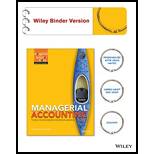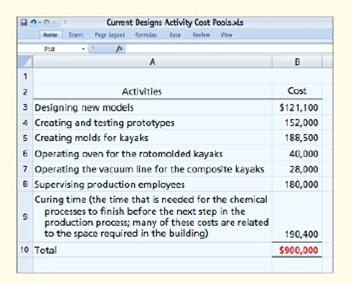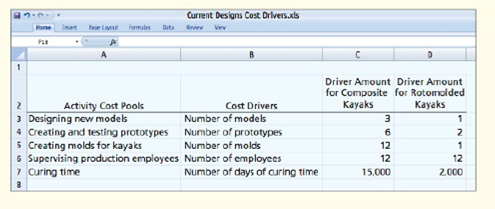
Concept explainers
CURRENT DESIGNS
As you teamed in the previous chapters. Current Designs has two main product lines—composite kayaks, which are handmade and very labor intensive, and rotomolded kayaks, which require less labor but employ more expensive equipment. Current Designs' controller, Diane Buswell, is now evaluating several different methods of assigning
Diane has decided to use the following activities and costs to evaluate the methods of assigning overhead.

As Diane examines the data, she decides that the cost of operating the oven for the rotomolded kayaks and the cost of operating the vacuum line for the composite kayaks can be directly assigned to each of these product lines and do not need to be allocated with the other costs.
Instructions
For purposes of this analysis, assume that Current Designs uses $234,000 in direct labor costs to produce 1,000 composite kayaks and $286,000 in direct labor costs to produce 4,000 rotomolded kayaks each year.
(a) One method of allocating overhead would allocate the common costs to each product line by using an allocation basis such as the number of employees working on each type of kayak or the amount of factory space used for the production of each type of kayak. Diane knows that about 50% of the area of the plant and 50% of the employees work on the composite kayaks, and the remaining space and other employees work on the rotomolded kayaks. Using this information and remembering that the cost of operating the oven and vacuum line have been directly assigned, determine the total amount to be assigned to the composite kayak line and the rotomolded kayak line, and the amount to be assigned to each of the units in each line.
(b) Another method of allocating overhead is to use direct labor dollars as an allocation basis. Remembering that the costs of the oven and the vacuum line have been assigned directly to the product lines, allocate the remaining costs using direct labor dollars as the allocation basis. Then, determine the amount of overhead that should be assigned to each unit of each product line using this method.
(c) Activity-based costing requires a cost driver for each cost pool. Use the following information to assign the costs to the product lines using the activity-based costing approach.
 What amount of overhead should be assigned to each composite kayak using this method? What amount of overhead should be assigned to each rotomolded kayak using this method?
What amount of overhead should be assigned to each composite kayak using this method? What amount of overhead should be assigned to each rotomolded kayak using this method?
(d) Which of the three methods do you think Current Designs should use? Why?
Want to see the full answer?
Check out a sample textbook solution
Chapter 4 Solutions
Managerial Accounting, Binder Ready Version: Tools for Business Decision Making
 Cornerstones of Cost Management (Cornerstones Ser...AccountingISBN:9781305970663Author:Don R. Hansen, Maryanne M. MowenPublisher:Cengage Learning
Cornerstones of Cost Management (Cornerstones Ser...AccountingISBN:9781305970663Author:Don R. Hansen, Maryanne M. MowenPublisher:Cengage Learning Managerial AccountingAccountingISBN:9781337912020Author:Carl Warren, Ph.d. Cma William B. TaylerPublisher:South-Western College Pub
Managerial AccountingAccountingISBN:9781337912020Author:Carl Warren, Ph.d. Cma William B. TaylerPublisher:South-Western College Pub Managerial Accounting: The Cornerstone of Busines...AccountingISBN:9781337115773Author:Maryanne M. Mowen, Don R. Hansen, Dan L. HeitgerPublisher:Cengage Learning
Managerial Accounting: The Cornerstone of Busines...AccountingISBN:9781337115773Author:Maryanne M. Mowen, Don R. Hansen, Dan L. HeitgerPublisher:Cengage Learning


